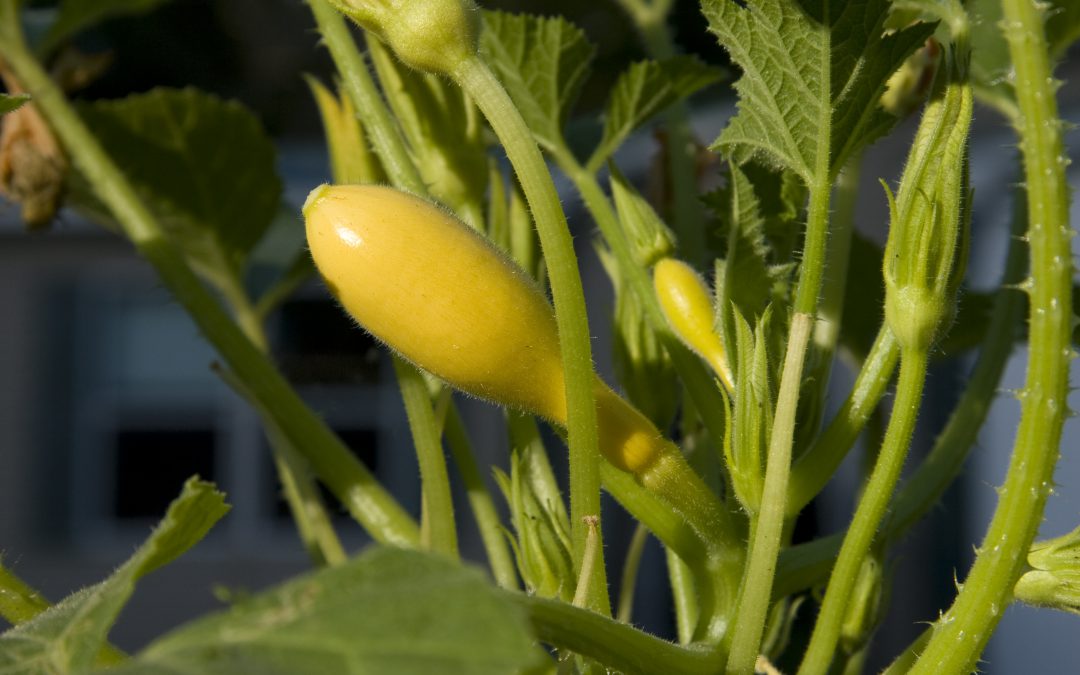
by Mary Salinas | Mar 18, 2021
The weather is warmer and plans and planting for spring vegetable gardens are in full swing. Last week many vegetable gardening topics were addressed in our Gardening in the Panhandle LIVE program. Here are all the links for all the topics we discussed. A recording of last week’s webinar can be found at: https://youtu.be/oJRM3g4lM78
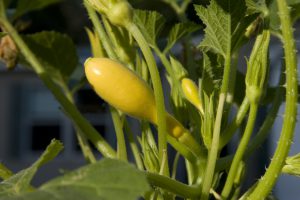
Home grown Squash. Gardening, vegetables. UF/IFAS Photo by Tom Wright.
Getting Started
The place to start is with UF’s ever popular and comprehensive Florida Vegetable Gardening Guide https://edis.ifas.ufl.edu/pdffiles/VH/VH02100.pdf
Many viewers expressed interest in natural methods of raising their crops. Take a look at Organic Vegetable Gardening in Florida https://edis.ifas.ufl.edu/pdffiles/HS/HS121500.pdf
The Square Foot Vegetable Planting Guide for Northwest Florida helps plan the layout of your garden https://sfyl.ifas.ufl.edu/media/sfylifasufledu/leon/docs/pdfs/Vegetable-Square-Foot-Planting-Guide-for-Northwest-Florida-mcj2020.pdf
Maybe you would like the convenience of starting with a fresh clean soil. Gardening in Raised Beds can assist you. https://edis.ifas.ufl.edu/ep472 Also see Gardening Solutions Raised Beds: Benefits and Maintenance https://gardeningsolutions.ifas.ufl.edu/design/types-of-gardens/raised-beds.html
Here is a guide to Fertilizing the Garden https://edis.ifas.ufl.edu/vh025
The Florida Panhandle Planting Guide will help you decide what to plant and when: https://www.facebook.com/SRCExtension/posts/4464210263604274
The Ever-Popular Tomato
To start your journey to the best tomatoes, start with UF/IFAS Gardening Solutions – Tomatoes https://gardeningsolutions.ifas.ufl.edu/plants/edibles/vegetables/tomatoes.html
If you are looking to grow in containers: https://sfyl.ifas.ufl.edu/media/sfylifasufledu/leon/docs/pdfs/Container-Gardening-Spacing-Varieties-UF-IFAS-mcj2020.pdf
Vegetable grafting is gaining in popularity, so if interested, look at this Techniques for Melon Grafting: https://edis.ifas.ufl.edu/hs1257
Blossom end rot occurs when irrigation is irregular and the calcium in the soil does not get carried to the developing fruit. The U-Scout program has a great description of this common problem: https://plantpath.ifas.ufl.edu/u-scout/tomato/blossom-end-rot.html
Our moderators talked about some of their favorite tomato varieties. Josh Freeman is partial to Amelia, a good slicing tomato. Matt Lollar shared some of the best tomato varieties for sauce: Plum/Roma types like BHN 685, Daytona, Mariana, Picus, Supremo and Tachi. For cherry tomatoes, Sheila Dunning recommended Sweet 100 and Juliette.
Whatever variety you choose, Josh says to pick when it starts changing color at the blossom end and bring it indoors to ripen away from pests.
Garden Pest Management
Let’s start with an underground pest. For those of you gardening in the native soil, very tiny roundworms can be a problem. Nematode Management in the Vegetable Garden can get you started: https://edis.ifas.ufl.edu/pdffiles/NG/NG00500.pdf
Leaffooted bugs are quite a nuisance going after the fruit. Here is how to control them: http://extension.msstate.edu/newsletters/bug%E2%80%99s-eye-view/2018/leaffooted-bugs-vol-4-no-24
Cutworms are another frustration. Learn about them here: https://nwdistrict.ifas.ufl.edu/hort/2020/02/27/cutworms-the-moonlit-garden-vandals/
Maybe your tomatoes have gotten eaten up by hornworms. https://gardeningsolutions.ifas.ufl.edu/care/pests-and-diseases/pests/hornworm-caterpillars.html
There are beneficial creatures helping to control the pest insects. Learn to recognize and conserve them and make for a healthier environment. Natural Enemies and Biological Control: https://edis.ifas.ufl.edu/pdffiles/IN/IN12000.pdf
If the beneficials are not numerous enough to control your pests, maybe a natural approach to pest control can help. Natural Products for Managing Landscape and Garden Pests in Florida: https://edis.ifas.ufl.edu/in197
Fungal and bacterial problems can also plague the garden. Go to Integrated Disease Management for Vegetable Crops in Florida for answers: https://edis.ifas.ufl.edu/pdffiles/PP/PP11100.pdf
Get control of weeds early and consult Controlling Weeds by Cultivating & Mulching https://hgic.clemson.edu/factsheet/controlling-weeds-by-cultivating-mulching/
Companion planting is a strategy that has been around for ages and for good reason: https://www.almanac.com/companion-planting-chart-vegetables Some good flowering additions to the garden that Sheila talked about are bee balm, calendula, marigold, nasturtiums, chives, and parsley.
And Some Miscellaneous Topics…
Peppers are another popular crop. Get some questions answered here: https://aggie-horticulture.tamu.edu/archives/parsons/vegetables/pepper.html
When can we plant spinach in Northeast Florida? http://blogs.ifas.ufl.edu/nassauco/2017/07/15/q-can-plant-spinach-northeast-florida/
Figs are a great fruit for northwest Florida. Get started here: https://edis.ifas.ufl.edu/pdffiles/MG/MG21400.pdf and with this https://aggie-horticulture.tamu.edu/extension/homefruit/fig/fig.html
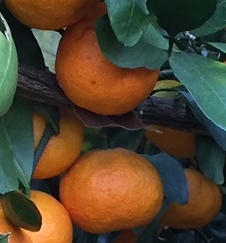
by Matthew Orwat | Jan 4, 2018
Every winter season in the Florida Panhandle is different. It can be wet or dry, frigid cold or unseasonably warm. We may have early frosts and early springs, or cold snaps in late march after fruit trees flower.
While we cannot determine the exact time to prune the dooryard fruit trees in our rather variable region, here are some tried and true guidelines for pruning the most popular edible garden plants in northwest Florida.
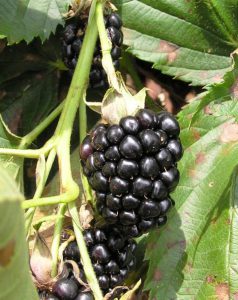 Blackberries
Blackberries
Blackberries are unusual in that they do not build a large structure and fruit for years on the same branches (in general). They actually fruit on previous years’ growth which then die after fruit production. The canes that produce fruit are called the floricanes. As the floricanes are producing fruit, the blackberry plants are growing primocanes. These are the new canes that will produce fruit for the next season. By then, these canes will have matured in to floricanes. A few new blackberry cultivars exist that produce fruit on new growth as well, but most Florida adapted cultivars are of the standard type. For pruning purposes, it is best to remove the floricanes just after fruiting, but be sure not to cut the new growth (primocanes) because that wood will bear next year’s fruit. For more information about the blackberry, please see publication HS807.
Blueberries
With blueberries older canes need to be removed to make room for younger, more productive canes. When a plant reaches four to five years old it is permissible to remove about 1/4–1/5 of the oldest canes each year which amounts to about one to three of the oldest canes. Performing this task will ensure that no cane is more than three or four years old. Thus, blueberry plantings will be in a constant state of renewal and not become excessively woody and nonproductive. To keep plants from becoming too tall, mature plants can be topped in the summer directly after fruit harvest. Removal of a few inches to a foot, depending on the cultivar, will stimulate the new growth that will bear the next year’s fruit. See CIR 1192 for more information
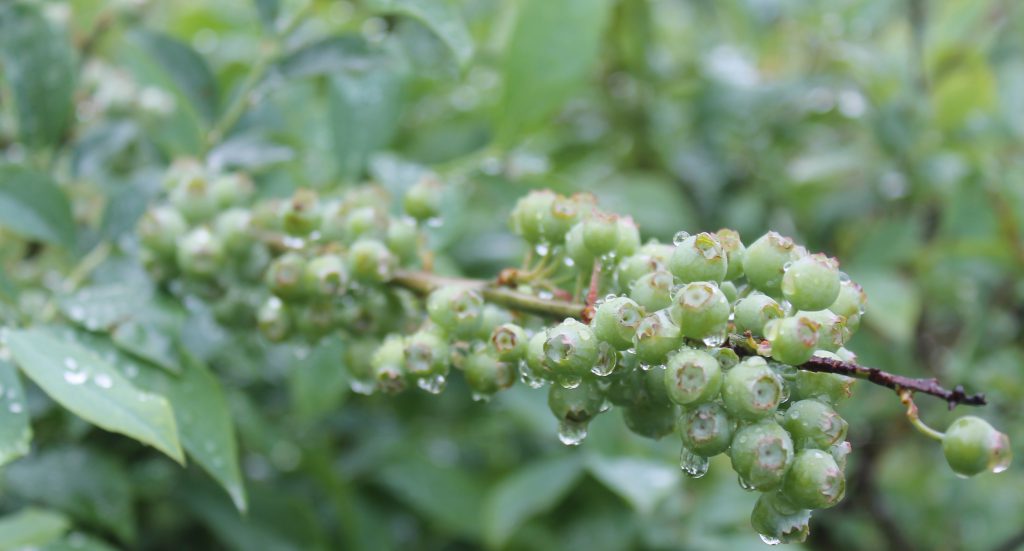
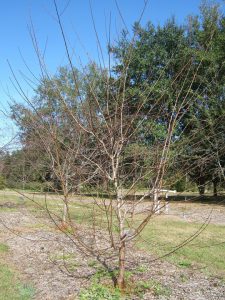 Temperate Fruit Trees
Temperate Fruit Trees
Pruning of temperate fruit trees (Peaches, Apples, Pears, Persimmons) should be done during the winter dormant period in most cases. This period, generally between December and February allows for some latitude. Pruning later in the dormant season is better in most seasons since trees are more susceptible to freeze damage after pruning, and pruning stimulates the growth of the trees. In Northwest Florida, a February pruning is usually most desirable, depending on the season (namely average high temperatures). Pruning for shape is also done in the summer months if necessary. This task should be limited to removing excessive growth and dead / diseased wood. See HS1111 and HS14 for more information.
Muscadines
Once harvest concludes, it is usually a grower’s natural inclination to immediately prune their muscadine vines. Pruning after harvest in early fall is not, however, best for maintaining plant condition and optimizing next year’s yield, especially if there is an early frost. Early frosts can surprise the plant before sugars have been moved to the roots for storage during dormancy. Therefore, waiting to prune in mid-January to mid-March will ensure that the vine has had adequate time to go dormant and acclimate to the winter season. For more information please see this article titled “Tips for Properly Pruning Muscadines”.
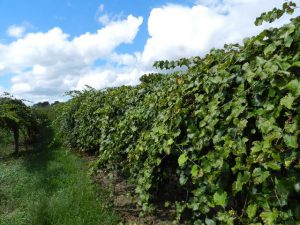
 Citrus
Citrus
Pruning is not necessary for citrus in every case, as it is in many temperate fruits, to have excellent production quality and quantity. Citrus trees perform excellently with minimal pruning. The only pruning necessary for most citrus is removing crossing or rubbing branches while shaping young trees, removing dead wood, and pruning out suckers from the root-stock. Homeowners may choose to prune citrus trees to keep them small, but this will reduce potential yield in a commercial setting, since bigger trees produce more fruit.
Often, maturing Satsuma trees produce long vertical branches. It is tempting to prune these off, since they make the tree look unbalanced. To maximize yield, commercial Satsuma growers allow these branches to weep with the heavy load of fruit until they touch the ground. This allows increased surface area for the tree, since the low areas around the trunk are not bare. Additionally, weeds are suppressed since the low branches shade out weed growth. The ground under the trees remains bare, thus allowing heat from the soil to radiate up during cold weather events. The extra branches around the trunk offer added protection to the bud union as well. If smaller trees are desired for ease of harvest, ‘flying dragon’ root-stock offers dwarfing benefits, so that the mature scion cultivar size will only grow to 8-10 feet tall.
Fig
Figs should be pruned after fruit production, which usually occurs in early summer. In the winter it is fine to remove dead or diseased wood, but drastic trimming will reduce yield since fruit is borne at the terminal of the previous year’s growth. For more information, please consult publication HS27.
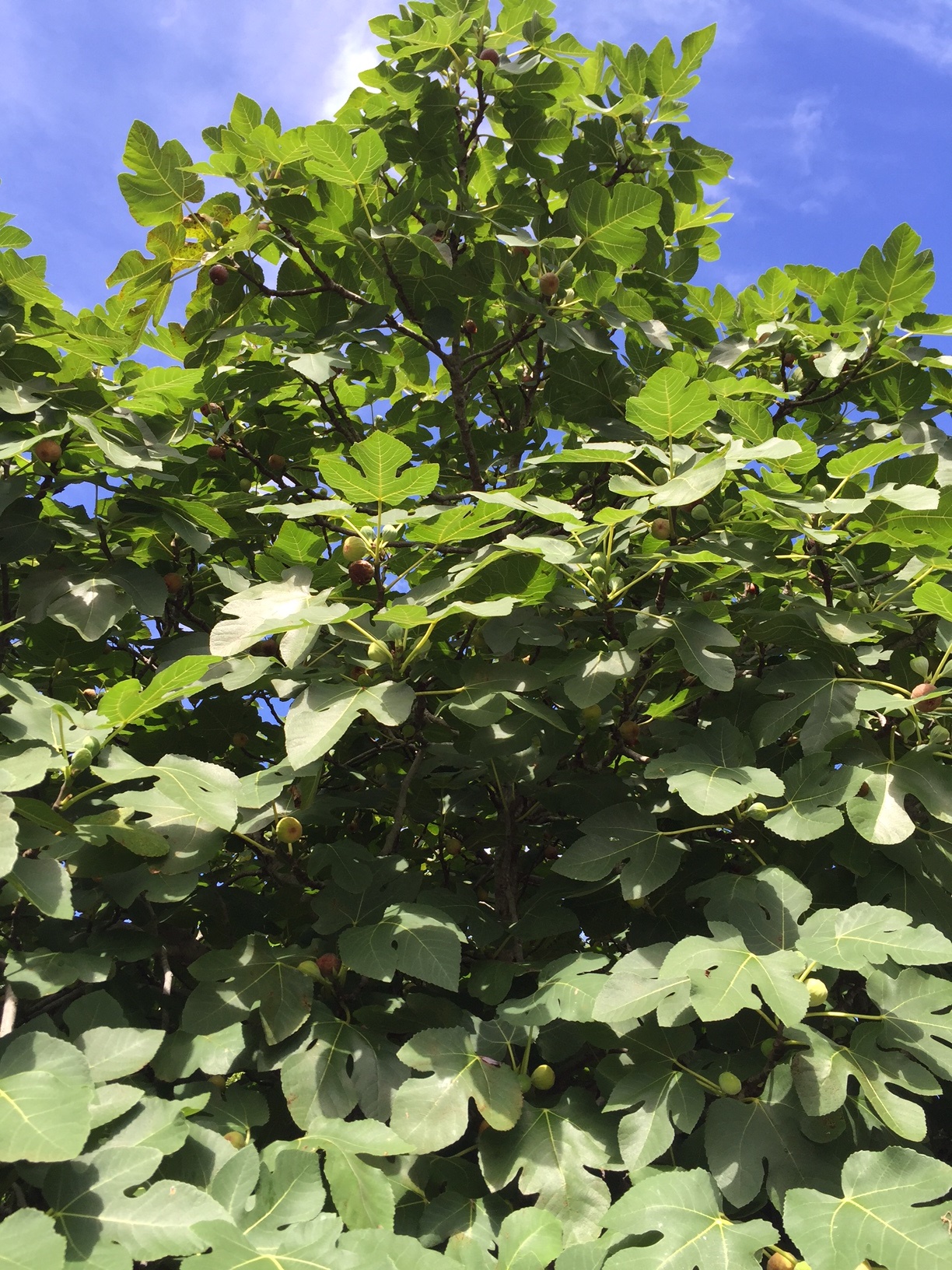
by Carrie Stevenson | Jul 26, 2016
Summer is full of simple pleasures—afternoon rainstorms, living in flip flops, and cooling off in a backyard pool. Among these, one of my favorites is walking out my door and picking handfuls of figs right from the tree. Before we planted our tree, my only prior experience with the fruit was a Fig Newton—I’d never eaten an actual fig, much less one picked fresh. Now, they are my favorite fruit.
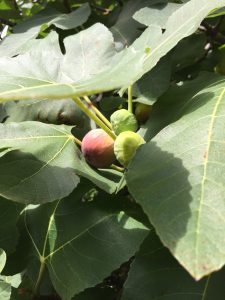
When ripe, figs are a deep shade of pink to purple. Larger green figs will ripen over the course of a few days. Photo credit: Carrie Stevenson
Native to Asia Minor and the Mediterranean, figs were introduced to Florida in the 1500’s by Spanish explorers. Spanish missionaries introduced these relatives of the mulberry to California a couple hundred years later. Figs are best suited to dry, Mediterranean-type climates, but do quite well in the southeast. Due to our humidity, southern-growing figs are typically fleshier and can split when heavy rains come through. The biggest threats to the health of the trees are insects, disease (also due to our more humid climate) and root-knot nematodes.
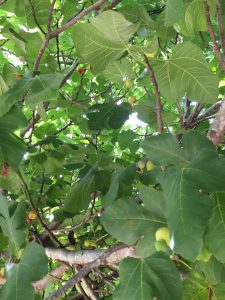
Fig trees can grow quite large and produce hundreds of fruit each year. Photo credit: Carrie Stevenson
Our tree started out just a couple of feet tall, but 12 years ago we replanted it along a fence in our back yard. It has grown so large (easily 25 feet tall and equally wide) that it hangs over our driveway, making it handy to grab a few as I hop in the car to run errands. The tree is in full sun at the bottom of a slope, and seems to be a satisfied recipient of all the runoff from our backyard. This position has resulted in a thick layer of soil and mulch in which it thrives.
We usually see small green fruit start to appear in early May, becoming fat and ripe by the second half of June. The tree produces steadily through early August, when the tree’s leaves turn crispy from the summer heat and there’s no more fruit to bear. The common fig doesn’t require a pollinator, so only one tree is necessary for production. The fiber-rich fig is also full of calcium, potassium, and vitamins A, E, and K. As it turns out, the “fruit” is actually a hollow peduncle (stem) that grows fleshy, forming a structure called a synconium. The synconium is full of unfertilized ovaries, making a fig a container that holds both tiny flowers and fruit in one.
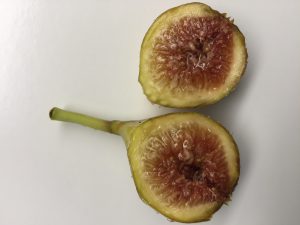
The insides of a fig show the small flowering structures that form the larger fruit. Photo credit: Carrie Stevenson
With the hundreds of figs we’ve picked, my family has made fig preserves, fig ice cream, baked figs and of course eaten them raw. We typically beg friends and neighbors to come help themselves—and bring a ladder—because we can’t keep up with the productivity. Often you can tell you’re near our tree from around the block, as the aroma of fermenting fruit baking on the driveway is far-reaching.
No matter what you do with them, I encourage planting these trees in your own yard to take full advantage of their sweet, healthy fruit and sprawling shade. As Bill Finch of the Mobile (AL) botanical gardens has written, “fresh…figs are fully enjoyed only by the family that grows them, and the very best figs are inevitably consumed by the person who picks them.”

by Mary Salinas | Jul 20, 2015
July always brings the blessing of abundant figs on my trees. A new crop waits to be picked and enjoyed every day for nearly a month. The tender sweet fruit can be enjoyed fresh, prepared into jams or used in a myriad of recipes.
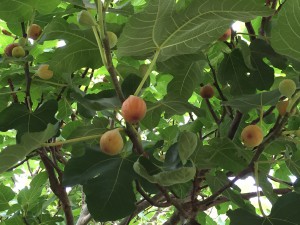
Ripe figs ready to pick. Photo credit: Mary Derrick, UF/IFAS Extension.
The fig (Ficus carica) is native to Asia Minor and the Mediterranean regions of the world and has been cultivated for an estimated 7,000 years. Spanish explorers brought the fig with them to Florida in 1575 and it has had a presence here ever since. Since the fig is adapted to a dry climate in its native regions, the humidity it encountered in Florida can cause fruit to split; but new cultivars have been developed to minimize this problem.
Fig trees usually grow to a maximum of 25 feet and have large bright green leaves that fall in the autumn. Fruit develops from June to August, depending on the chosen cultivar.
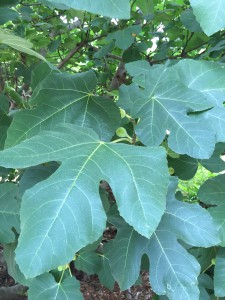
The large fig leaves are quite ornamental. Photo credit: Mary Derrick, UF/IFAS Extension.
Choose a spot for planting a fig tree that receives full sun and good drainage. Once established, figs are drought tolerant and only need supplemental irrigation if we have an extended drought. No structural pruning is required but you can prune to keep the tree from growing so tall that you cannot pick the delicious fruit. Be sure to do your pruning just after the fruit is gone as the fruit develops on the terminal ends of the branches from last year’s growth.
Many figs grow and fruit sufficiently without applied fertilizer, however, a light fertilization with a 10-10-10 with micronutrients can be helpful for small trees getting established and those with reduced fruiting. Young trees can benefit from a ½ pound three to five times from February to August while large trees could use up to 4 pounds per application on the same schedule.
There are a few pests that do damage figs; the most common, though, are the birds and squirrels that get the fruit before you do. Seldom do figs need to be sprayed when grown in the home garden.
For more information:
The Fig
Fig nutrition facts and recipes














